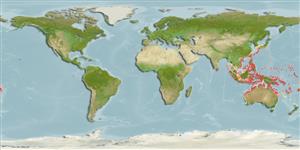Actinopterygii (ray-finned fishes) >
Tetraodontiformes (Puffers and filefishes) >
Monacanthidae (Filefishes)
Etymology: Paramonacanthus: Greek, para = the side of + Greek, monos = one + Greek, akantha ) thorn (Ref. 45335).
Environment / Climate / Range
Ecology
Marine; demersal; depth range 3 - 25 m (Ref. 90102). Tropical, preferred ?
Western Pacific: Thailand, Malaysia, northwestern Australia, Philippines, Indonesia, and New Guinea.
Size / Weight / Age
Maturity: Lm ? range ? - ? cm
Max length : 11.0 cm SL male/unsexed; (Ref. 33065)
Dorsal
spines
(total): 2;
Dorsal
soft rays
(total): 27-31;
Anal
spines: 0;
Anal
soft rays: 28 - 32;
Vertebrae: 19. Dorsal profile of snout straight to convex in male, small hump sometimes over or slightly in advance of nostrils; straight to concave in female and juvenile, without hump. First dorsal spine originating over posterior half of eye, or slightly behind eye. With dark brown to dusky blotches, sometimes tending to form two curved, oblique stripes on body, first from rear of soft dorsal fin to pectoral fin, second from caudal fin base to ventral flap; three dark brown blotches nearly always present.
Inhabits sheltered coastal reefs, usually forming small aggregations (Ref. 48637). Also found in mud and sand bottoms of trawling grounds (Ref. 90102).
Life cycle and mating behavior
Maturity | Reproduction | Spawning | Eggs | Fecundity | Larvae
Hutchins, J.B., 1997. Review of the monacanthid fish genus Paramonacanthus, with descriptions of three new species. Rec. West. Aust. Mus. Suppl. No. 54:1-57. (Ref. 33065)
IUCN Red List Status (Ref. 115185)
CITES (Ref. 94142)
Not Evaluated
Threat to humans
Harmless
Human uses
More information
Common namesSynonymsMetabolismPredatorsEcotoxicologyReproductionMaturitySpawningFecundityEggsEgg development
ReferencesAquacultureAquaculture profileStrainsGeneticsAllele frequenciesHeritabilityDiseasesProcessingMass conversion
Tools
Special reports
Download XML
Internet sources
